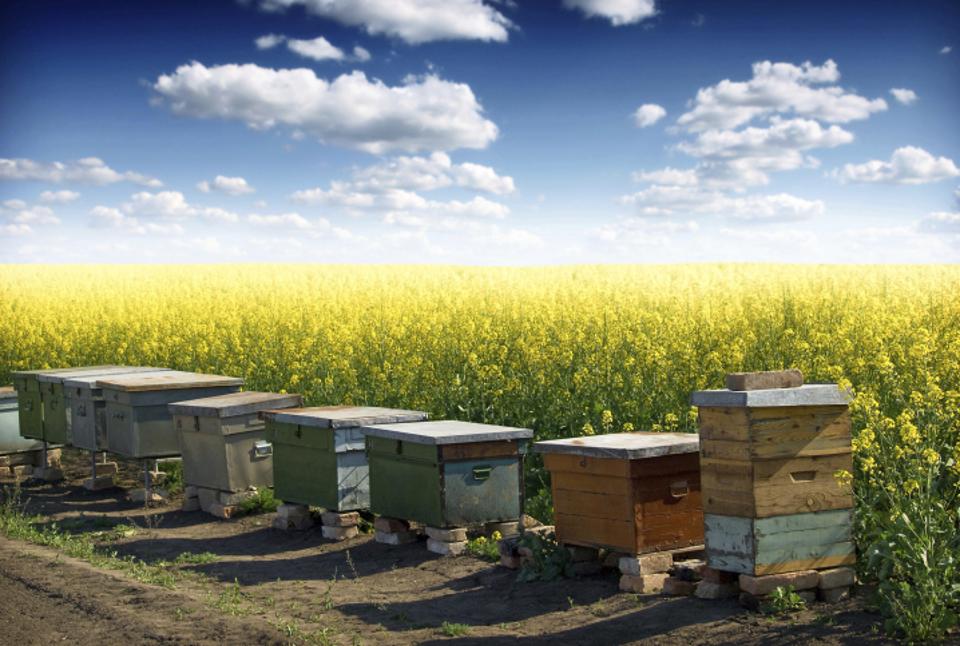Preserving Honey Bees Means Protecting Our Food Supply
This post was originally published on Forbes on December 9, 2016.
Post written by Nancy Kavazanjian and Jay Hill. Nancy, with Hammer and Kavazanjian Farms, is a corn, soybean and wheat farmer. Jay, with Hill Farms, is a vegetable, nut and beef farmer.

This year, we established 16 acres of pollinator habitat on our Wisconsin corn, soybean and wheat farm. With honey bees dying at higher rates, agriculture is part of the solution in preserving this important species. We’ve made this part of our Conservation Stewardship Program, and my husband and I are pretty proud of this.
Not only do these sustainable improvements benefit pollinators and wildlife, they also strengthen our farm because buffer habitats and better pasture management reduces erosion, increases soil health, and improves water quality.
With honey bees pollinating one-third of our food supply, these insects play a critical role in moving our food system forward. However, a U.S. Department of Agriculture survey shows that winter colony loss rate of honey bees this past year was 28%, up from 22% the year prior. Overall, honey bee populations are not in decline; they are just dying at higher rates compared to previous years.
One of the primary reasons for the high rate of honey bee deaths is attributable to non-native varroa mites, which infest colonies and feed on adult and worker bees spreading viruses. Additional stress factors on honey bee health include poor nutrition and pesticide exposure, which organizations like Honey Bee Health Coalition are addressing.
“Varroa mites, first found in Asia, came to North America in the late 1980s – and prior to their introduction in the U.S., pollinator viruses were not very virulent, rarely killing their honey bee hosts,” says Dennis vanEngelsdorp, entomologist at University of Maryland. “However, once varroa mites came to this country, they changed the way viruses spread, and, as a result, viruses became more virulent and started killing more colonies.”
Dennis also notes it’s important for beekeepers to keep in mind – you can’t prevent your colonies from getting varroa. What you need to do is monitor and manage mite populations so they don’t get too high. Right now, national surveys show most colonies sampled have mite levels higher than we think colonies can survive without damage. If we want to understand the contribution other factors – like poor nutrition and pesticides – have on colonies in real world conditions, we first need to clean up varroa populations.
In preserving pollinators, one remedy includes careful examination of spraying plans and insecticidal seed treatments to ensure we’re only using the products we need, when we need them. And as farmers, we’re working with the USDA to create enhanced habitats.
How we protect bees on our New Mexico farm
- Creating “pollinator highway” – Planting perennial grasses and flowering plants is key in attracting pollinators. If we provide for the bees, they will pollinate the seed crops enhancing the plants’ quality and productivity.
- Honey bee placement – We designate sections of crops that will and will not be sprayed to cultivate healthy pollinator process. If honey bees are in the vicinity, we’ll wait to spray or have someone remove the bees.
- Prioritizing beneficial insects versus harmful insects – We avoid applications in fields where there are more beneficial insects compared to harmful insects. We strategically place honey bees where they can easily do their jobs without us interfering.
- Treating pollinators like our animals – We aim to create the best possible environment for pollinators, just like livestock farmers do for their animals.
Keeping environment top of mind – Farmers spend every day outside in the soil, breathing the air and using the water to produce a sustainable food supply, so maintaining a healthy environment where we live is important to both us and the bees.
Without bees, we wouldn’t have seed for next year’s crop, and that’s why we collaborate so closely with today’s beekeepers.
Nancy Kavazanjian, a corn, soybean and wheat farmer in Beaver Dam, Wis., is Immediate Past Chairwoman of the U.S. Farmers and Ranchers Alliance. The motto for their farm is “Our Soil. Our Strength.” which is a top priority for Nancy in farming sustainably and preserving the land for future generations.
Jay Hill, co-owner of Hill Farms in Las Cruces, New Mexico, focuses on vegetable, nut and beef production farming nearly 1,000 acres. Jay is also one of the U.S. Farmers and Ranchers Alliance’s Faces of Farming & Ranching. He’s inspired to grow a good tasting, safe product in the most cost effective way for his customers.